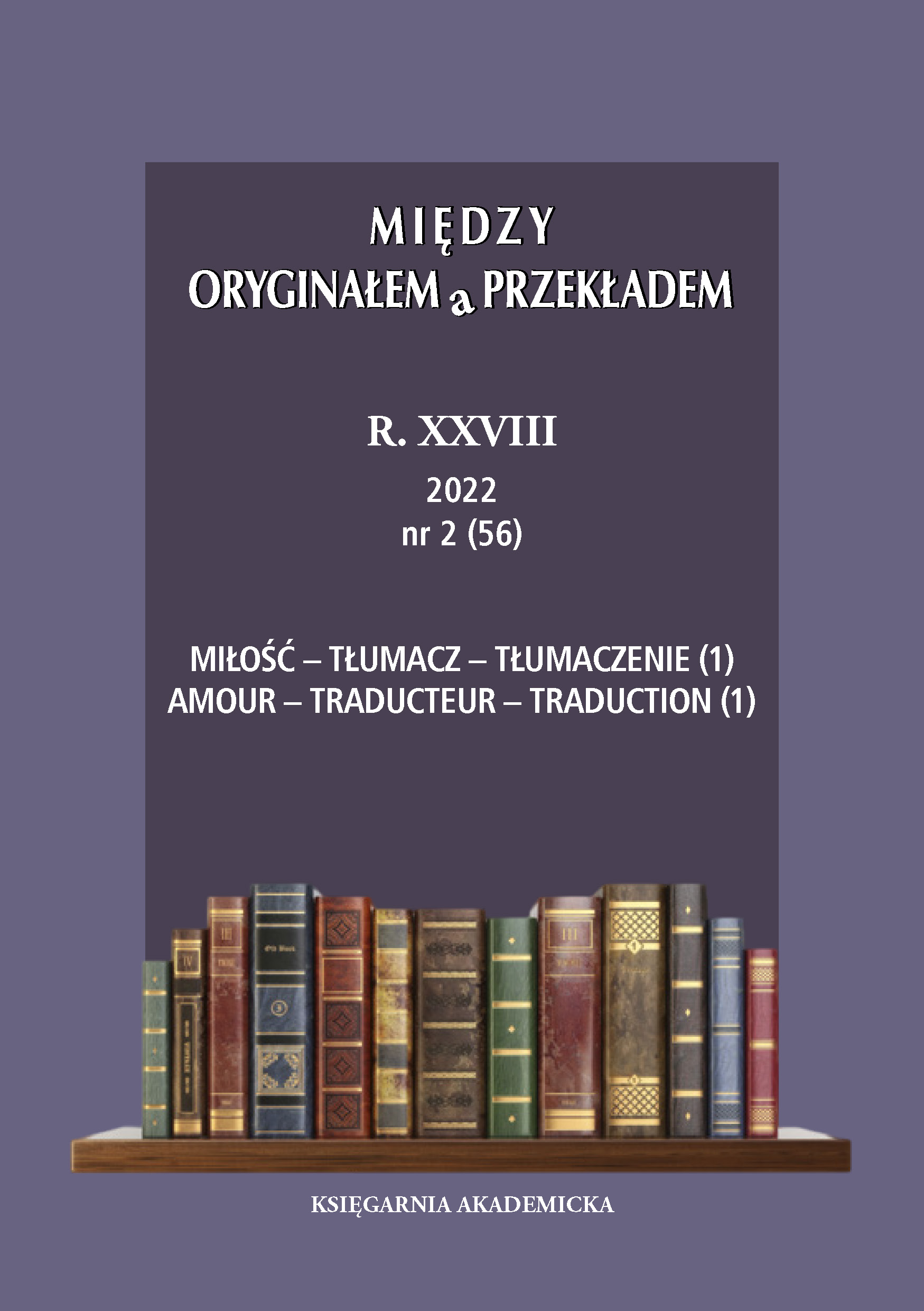Miłość w cieniu traumy w powieści Le mort qu’il faut Jorgego Semprúna i w jej przekładach na hiszpański i polski
DOI:
https://doi.org/10.12797/MOaP.28.2022.56.02Keywords:
concentration camp prose, trauma, emotions, literary translationAbstract
LOVE IN THE SHADOW OF TRAUMA IN THE NOVEL LE MORT QU’IL FAUT BY JORGE SEMPRÚN AND ITS TRANSLATIONS INTO SPANISH AND POLISH
Testimonies of concentration camps prisoners are usually exceptionally emotional. The ways of expressing feelings in this kind of writings is a relatively little explored issue, and the existing case studies focused on linguistic markers of negative emotions, such as horror, despair and gloom. However, the range of feelings expressed in the memories of the survivors is much wider and includes also emotions such as friendship, love, and compassion. The article analyzes excerpts from Jorge Semprún’s novel Le mort qu’il faut, particularly those which show feelings for a woman, and their translations into Spanish and Polish. The purpose of the analysis is to list the techniques used by specialists to translate these passages and to evaluate to what extent they managed to convey their emotional temperature.
Downloads
References
Analizowane teksty
Semprún, J. (2001/2016), Le mort qu’il faut, Gallimard, Paris, wydanie elektroniczne.
Semprún, J. (2001), Viviré con su nombre, morirá con el mío, tłum. Carlos Pujol, editor digital: Titivillus, México DF, wydanie elektroniczne.
Semprún, J. (2002), Odpowiedni trup, tłum. Maryna Ochab, Czytelnik, Warszawa.
Opracowania
Carbaugh, D. (1990), “Toward a Perspective on Cultural Communication and Intercultural Contact”, Semiotica. 80: 15-35. DOI: https://doi.org/10.1515/semi.1990.80.1-2.15
Ferrán, O. Herrmann G., red. (2014), A Critical Companion to Jorge Semprún: Buchenwald, Before and After, Palgrave Macmillan, New York.
Ferrán, O. Herrmann G., (2014), Introduction, [w:] Ofelia Ferrán, Gina Herrmann, red. A Critical Companion to Jorge Semprún: Buchenwald, Before and After, Palgrave Macmillan, New York, 1-36.
Gaszyńska-Magiera, M. (2019), Tożsamość w obozie koncentracyjnym. Wokół przekładów powieści Jorgego Semprúna Le mort qu’il faut na polski i hiszpański, [w:] Ewa Gruszczyńska, Małgorzata Guławska-Gawkowska, Anna Szczęsny, red. Translatoryczne i dyskursywne oblicza komunikacji, Instytut Lingwistyki Stosowanej WLS UW, Warszawa, 13-26.
Hénaff, L. (2011), “La littérature ou la vie: l’obsession de la littérarité chez Jorge Semprun”, @nalyses. Revue de critique et de théorie littéraires. 6(3): 115-149 [online] https://uottawa.scholarsportal.info/ottawa/index.php/revue-analyses/article/view/647-, 25.11.2020.
Kulesza, D. (2017), „Polska literatura obozowa. Kilka pytań o syntezę, której nie ma”, Acta Universitatis Lodziensis. Folia Litteraria Polonica. 4(42): 23-41. DOI: https://doi.org/10.18778/1505-9057.42.02
Margalit, A. (2015), Emocje przypominane, [w:] Elżbieta Wichrowska, Anna M.
Szczepan-Wojnarowska, Roma Sendyka, Ryszard Nycz, red., Historie afektywne i polityki pamięci, Instytut Badań Literackich, Warszawa, 65-94.
Nazimek, J. (2015), „Dwa rodzaje dyskursów w polskiej literaturze lagrowej”, Annales Universitatis Paedagogicae Cracoviensis. Studia Historicolitteraria. 15: 55-63. DOI: https://doi.org/10.24917/3913
Polak, E. (1968), Morituri, Pax, Warszawa.
Puzynina, J. (2000), Uczucia a postawy we współczesnym języku polskim, [w:] Iwona Nowakowska-Kempna, Anna Dąbrowska, Janusz Anusiewicz, red., Uczucia w języku i tekście, Wrocław, 9-24, Język a Kultura, t. 14.
Schwarz-Friesel, M. (2015), Giving Horror a Name: Verbal Manifestations of Despair, Fear and Anxiety in Texts of Holocaust Victims and Survivors, [w:] DOI: https://doi.org/10.1075/ceb.10.15sch
Ulrike M. Lüdtke, red. Emotion in Language: Theory – Research – Application, John Benjamins Publishing Company, Amsterdam, 289-304.
Semprún, J. (1994), L’Écriture ou la vie, Gallimard, Paris.
Swoboda, T. (2014), Powtórzenie i różnica. Szkice z krytyki przekładu, Wydawnictwo w Podwórku, Gdańsk.
Tokarz, B. (2015), „Tłumacz, emocje i przekład”, Poznańskie Studia Slawistyczne. 9: 381-394. DOI: https://doi.org/10.14746/pss.2015.9.23
Tokarz, B. (2017), Miejsce emocji w przekładzie, [w:] Piotr Fast, Tamara Brzostkowska-Tereszkiewicz, Justyna Pisarska, red. Przekład i emocje, Wydawnictwo „Śląsk”, Katowice, 7-32.
Wierzbicka, A. (1990), Podwójne życie człowieka dwujęzycznego, [w:] Władysław Miodunka, red. Język polski w świecie, PWN, Warszawa–Kraków, 71-104.
Wierzbicka, A. (1999), Mówienie o emocjach. Semantyka, kultura i poznanie, [w:] Anna Wierzbicka, Język – umysł – kultura, Jerzy Bartmiński, red. PWN, Warszawa, 138-162.
Downloads
Published
Issue
Section
License

This work is licensed under a Creative Commons Attribution-NonCommercial-NoDerivatives 4.0 International License.






